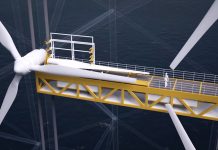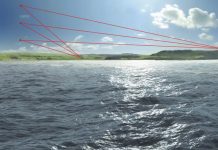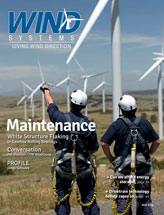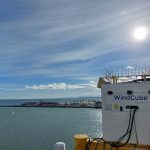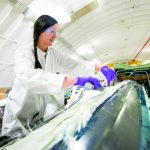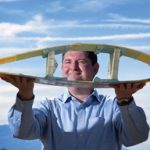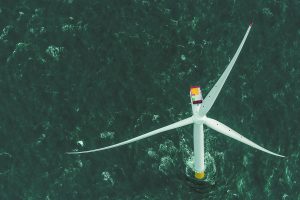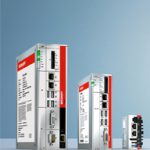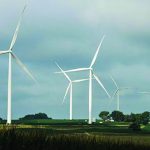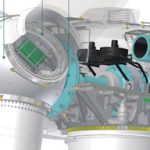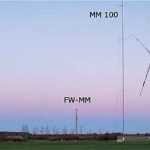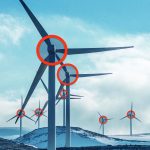From The Switch
In the wind power industry, the debate on which generator and converter option makes for the best modern wind turbine drivetrains is still raging. Numerous technology experts and industry commentators promote the use of the double-fed induction generator technology, while expressing doubts about the advantages of the permanent magnet generator (PMG) approach.
Total life cycle cost efficiency
It is sometimes claimed that permanent magnet generator (PMG) and full-power converter (FPC) drivetrains are more expensive than double-fed induction generator (DFIG) drive trains. However, research has established that when every investment and operational factor is taken into account, PMG-FPC drivetrains work out to be a cheaper, more cost-effective option over the total life cycle of the turbine.
True costs seen in grid connection
The lower grid connection costs of PMG-FPC equipped turbines represent a significant advantage over DFIG models. Efficiency and grid compliance are the top demands when it comes to generator selection. These factors, along with high annual energy production (AEP) and reliability, are very important from an investment point of view. While partial converters may have improved somewhat in grid code compliance, full-power converters remain the preferable option. As stated in the report, “Power System Architecture: Finding the Best Solution for a 5MW Turbine,” published by the engineering consulting company NextWind: “PMG is also a good choice for grid code compliance. Due to the full converter, all requirements for harmonics, power factor control, and grid fault ride-through can be met easily.”
DFIG technology now complies with the grid codes by adding hardware and software at the expense of extra costs. This is a simplistic answer to the problem, and is more of a quick fix than a concrete solution. With regards to DFIG, the NextWind study explains: “There is extra cost related to meeting new grid codes with the DFIG. With fault ride-through and power factor capability, the DFIG converter becomes similar in size and cost to the full converter.”
A key benefit of PMG-FPC drivetrain technology is the fact that it already includes features such as reactive power generation and low voltage ride-through (LVRT). These inherent benefits level the playing field when making comparisons with the cheaper upfront costs of double-fed induction generator drivetrains, which also need additional VAR support to make a connection to the network.
The long-term advantage comes from the extra energy produced with the higher power curve efficiencies of PMG technology. The PMG’s maximized energy production is what gives significantly higher income and profitability. Research conducted by Peter Jamieson and presented in the report, “Innovation in Wind Turbine Design 2011,” showed that PMG-FPC drivetrains produce more energy in low or medium wind conditions, leading to better income.
PMG-FPC drivetrains actually improve efficiency over the full operational range of the turbines. Although some claim that DFIGs are more efficient than PMGs at full load generation and in high, steady winds, in reality, the efficiency of the PMG-FPC and the DFIG plus partial converter are similar when operating at 100 percent power. However, we know that this situation rarely occurs, and in general working conditions, PMG drivetrains have proven to be more efficient. In fact, the lower the power, the lower the efficiency of the DFIG. In addition, the Ohmic losses in the DFIG winding due to the excitation power, which are more or less constant regardless of the output, also reduce the DFIG’s efficiency.
According to NextWind, “PMG has the highest annual power output, with a 2.2% increase in AEP over DFIG for an IEC (International Electrotechnical Commission) class II site.” PMG has a much higher efficiency curve, and this is especially true when operating at partial power, where the highest number of operational hours is spent. The report goes on to state: “A significant difference in power output becomes apparent when the operating speed range is taken into account. The PMG can begin producing power at very low rpms, but the DFIG is limited to a synchronous speed of less than 30%.”
In terms of operational performance, using the nominal point as the benchmark leads to incorrect assumptions, as the majority of a wind turbine’s lifetime is spent generating power at partial wind speeds. In effect, the lower the nominal speed of the DFIG, the poorer its operating characteristics, mainly regarding efficiency and power factor. Due to this, DFIGs are not used in direct-drive or medium-speed turbines at all. So, the only choice for those turbines is a synchronous machine, and most often, due to poor electrical performance, DFIG cannot be used on direct-drive machines at all.
Generator losses are always lower with PMG than with DFIG, since there are no excitation losses. The fact that DFIG only needs a partial converter reduces the difference in total drivetrain efficiency between these two concepts—especially at nominal loads. At partial loads, however, there is a significant difference—and this is where a wind turbine operates most often with fluctuating wind speeds. That’s why a PMG drive train results in higher AEP.
Another perceived advantage of turbines equipped with DFIG is that they only require partial converters, because only 25–30 percent of the input power is fed to the grid through the converter from the rotor; the rest goes directly to the grid from the stator. Because of this, little power is lost via the converter. Indeed, this idea is based on the incomplete assumption that the full-power converters required by PMGs are more expensive than the 20–35 percent rated capacity partial converters required by DFIG drivetrains. But the true question is: Which is more cost effective? Even in this case, PMG-FPC turbines work more efficiently because of the additional energy yield they provide in the partial power range over the entire lifetime of a wind turbine, which ensures a better return on investment.
At medium or low wind speeds, PMG models are undoubtedly more efficient, but what about at high wind speeds? When it comes to high-speed drivetrains, the outdated belief that PMG does not appear to offer any great advantage over a modern DFIG when used with a high-speed drivetrain needs clarification. The situation varies wildly depending on the wind class. With high average-wind speeds, the DFIG turbine operates closer to the rated point, and can close the efficiency gap on PMGs to some extent. However, even during high average-wind speed, PMG still offers advantages over a DFIG in terms of installation, operation, maintenance, and actualized value for money. Maximized AEP is one of the real priorities for customers and investors, and PMG turbines can accrue up to 7 percent more than DFIG designs, even when used with a high-speed drivetrain.
PMG designs also enhance reliability and serviceability, leading to lower O&M costs. It is important to bear in mind the required servicing and total reliability of the drive train. As the wind energy update by Sciemus, entitled “Big Data—How Applied Analytics Can Enhance Your O&M Programmes,” confirms, PMG designs have a “comparatively low number of electrical faults and failures (0.59 failures per year vs. 0.69 for other technologies).” The report continues: “The latest PMG machines are most reliable in terms of downtime per unit at 1.98 days per year, where all other technologies are >2.36 failures per year—an 18% improvement. This is due to low failure rates across each of the seven failure modes and indicates that industry learning and feedback is being incorporated into the latest machines.”
One Chinese wind turbine manufacturer realized enormous cost savings by minimizing its O&M crew. Compared to PMG technology, turbines operating with DFIG technology required a 2.8 times larger workforce for a comparable number of installed turbines.
In its recent study, NextWind estimated that annual service costs for DFIGs, including the additional service costs of the needed gearbox, would be 20–30 percent higher than the service costs for PMGs. The report goes on to say: “The improvements in annual energy production (AEP) and cost of service for the PMG outweighs the higher up-front costs, and that a wind turbine with a PMG will achieve a lower cost of energy compared to a wind turbine equipped with a DFIG.”
The rare-earth magnets required by PMGs can be perceived as an inherent risk, on the grounds of cost, price volatility, and availability. While it is true that rare earth is needed for PMG turbines, magnets are not as expensive as they once were, and the price level has stabilized considerably. The amount of rare earth magnets needed varies depending on the generator type: direct drive, medium speed, or high speed. Also the magnet arrangements can be optimized to lower the amount of rare earth materials needed. Finally, this price premium difference is offset by the lack of winding needed in the rotor, as needed with DFIG; manufacturing and assembling the rotor winding is time-consuming and expensive.
NextWind’s study came to the conclusion that PMGs are “the clear choice for optimizing all factors affecting the cost of energy of the installed turbine.”
The reliability factor
It’s wrongly assumed that PMG-FPC solutions require lots of potentially unreliable electronics. This commonly admitted myth states that full-power converters are not very reliable because they rely greatly on power electronics, which would be more prone to faults than gearboxes. This is inaccurate. In reality, the amount of electronics used in PMG-FPC drive trains is comparable to DFIG systems. Indeed, partial-load converters rely on the same electronics as full-power converters, but only scaled to lower power ratings. Power electronics failures will have the same consequences on PMG-FPC and DFIG plus partial-converter drivetrains alike.
More importantly, it is worth noting that there are no electronics used in the PMG generator itself, only in the converters. Furthermore, when considering a multi-megawatt system, a DFIG solution most likely consists of only one converter for the rotor connection, while a full-power converter system can consist of several parallel power threads. As semiconductors do fail, it is better to have the still healthy power threads in operation despite a failure in one of them, allowing the turbine to run at limited partial power, rather than having the whole turbine at a standstill due to a failure in power electronics.
The NextWind report came to the conclusion that PMGs have higher reliability and lower maintenance costs than DFIGs due to better heat performance, as well as being able to function without slip rings or encoders. “The DFIG creates a negative impact on reliability and increased maintenance cost due to increased gearbox loads from grid transients. Shifts in grid voltage and frequency result in high-cycle tooth-loads on the gearbox, resulting in micro pitting. Additionally, slip rings require inspection at six-month intervals and frequent replacement. In low temperature or marine environments, the maintenance interval may be even shorter.”
Sciemus engineering experts proved that “Direct Drive and hybrid PMG machines are some of the most reliable on the market.” This was “in part down to the superior reliability of the PMGs (0.11 failures per year) in comparison to the other generator technologies shown (0.12 – 0.14 failures per year).”
PMGs require the use of NdFeB magnets, which are sensitive to corrosion and heat. For this reason, some industry commentators claim that electrical losses could climb rapidly due to excessive heat. They also wrongly assume that there is a risk of reversed polarity or permanently losing magnetic field strength.
Such statements seem to ignore the fact that NdFeB magnets are always coated, which helps to protect them from corrosion very efficiently. Hermetic sealing is also applied when assembling the rotor, which also helps in this regard. It is also untrue that there is a sudden jump in electrical losses if the temperature rises above 80° C. In addition, the risk of reversed polarity is always taken into account during the design phase as well as tested with the prototype generators in the test bench. With these precautions in place, the risk of reversed polarity is close to zero.
From a manufacturing perspective, having the appropriate production quality standards and engineering skills is necessary to ensure the performance of the PMG-FPC drive trains. Manufacturing large PMGs for direct-drive turbines requires a high degree of expertise. Indeed, air gaps between rotor and stator demand tighter tolerances, and being able to maintain these standards when machining components 6 meters in diameter demands a level of skill and experience not found in all manufacturers. But with proper design and manufacturing standards in place, there are no special arrangements needed to maintain an air gap in large, direct-drive turbines. Table 1
PMG-FPC solutions offer much better maintenance conditions than DFIG drivetrains. PMG designs enhance reliability and serviceability as they require no slip rings or brushes and comply more easily with grid codes. Although DFIG solutions have made some improvements to historical challenges like brushes, bearings, and insulation, as long as DFIGs still use brushes, then they are likely to encounter problems such as sparks, consumable parts, and the need for regular maintenance and replacement. Brushes must be replaced regularly, whereas the so-called brushless DFIG machines have significant drawbacks, such as low efficiency, larger sizes and a very complex physical construction. Therefore, they are not widely used in wind applications.
As Sciemus also confirms, PMG designs have a “comparatively low number of electrical faults and failures.” The report continues on to say that, in terms of downtime, the latest PMG machines are most dependable, thanks to the minimal rate of failure in each of the seven modes.
|
|
www.theswitch.com | ||||
|
|
theswitch.fi |
|
@theswitchenergy |
|
the-switch_2 |
















